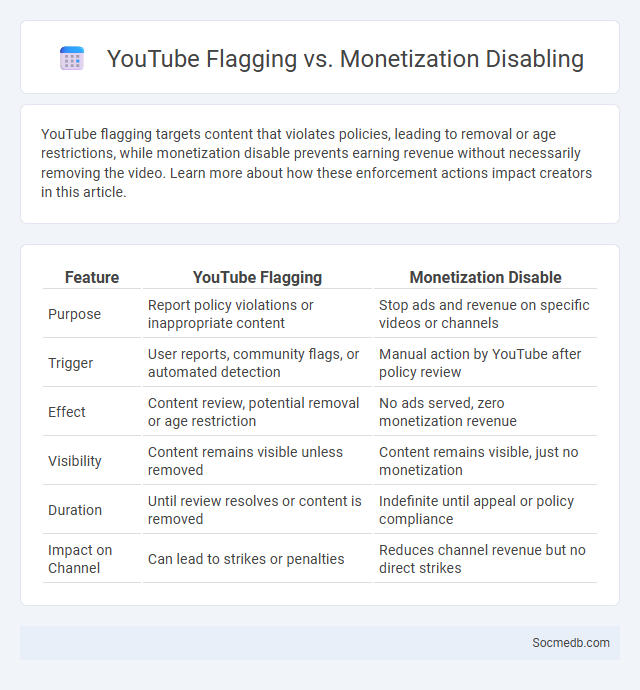
Photo illustration: YouTube Flagging vs Monetization Disable
YouTube flagging targets content that violates policies, leading to removal or age restrictions, while monetization disable prevents earning revenue without necessarily removing the video. Learn more about how these enforcement actions impact creators in this article.
Table of Comparison
| Feature | YouTube Flagging | Monetization Disable |
|---|---|---|
| Purpose | Report policy violations or inappropriate content | Stop ads and revenue on specific videos or channels |
| Trigger | User reports, community flags, or automated detection | Manual action by YouTube after policy review |
| Effect | Content review, potential removal or age restriction | No ads served, zero monetization revenue |
| Visibility | Content remains visible unless removed | Content remains visible, just no monetization |
| Duration | Until review resolves or content is removed | Indefinite until appeal or policy compliance |
| Impact on Channel | Can lead to strikes or penalties | Reduces channel revenue but no direct strikes |
Understanding YouTube Flagging: What It Means
YouTube flagging occurs when users mark content they believe violates community guidelines, signaling potential issues such as inappropriate language, hate speech, or copyright infringement. This process helps YouTube's moderation team review flagged videos to determine whether removal or restrictions are necessary to maintain platform safety. Understanding YouTube flagging empowers creators and viewers to recognize the platform's commitment to content standards and community well-being.
How Monetization Disables Affect Content Creators
Monetization disables on social media platforms directly impact content creators by limiting their ability to generate income from videos, posts, or livestreams, often due to algorithm changes or policy violations. This reduction in revenue can hinder your capacity to invest in better equipment, manage consistent content production, and sustain audience engagement. Platforms must strike a balance between enforcing guidelines and supporting creators' financial growth to maintain a vibrant, motivated community.
Flagging vs. Monetization Disable: Key Differences
Flagging content on social media involves users reporting posts that violate platform policies, triggering reviews and potential removal to maintain community standards. Monetization disable occurs when platforms prevent creators from earning revenue on specific content due to policy breaches or guidelines, impacting Your potential income. Understanding these distinctions helps you navigate content regulation and protect Your earnings effectively.
Reasons Behind YouTube Video Flagging
YouTube video flagging often occurs due to violations of community guidelines such as hate speech, copyright infringement, and misinformation. Videos containing inappropriate content like violence, nudity, or spam are frequently reported by users to maintain the platform's safety and integrity. User flagging helps YouTube algorithms and moderators identify and review problematic content efficiently to ensure compliance with policies.
Common Causes for Monetization Disable on YouTube
YouTube monetization can be disabled due to common causes such as repeated copyright violations, ads policy breaches, and invalid click activity. Your channel must comply with YouTube's community guidelines and advertiser-friendly content standards to maintain monetization eligibility. Understanding these rules helps protect your revenue stream and ensures adherence to platform policies.
YouTube’s Policy Enforcement: Detection and Consequences
YouTube's policy enforcement relies on advanced AI-powered detection systems that identify content violating community guidelines, including hate speech, misinformation, and copyright infringement. Your videos may be subject to removal, strikes, or demonetization if found non-compliant, affecting channel visibility and revenue. Consistent violations can lead to account suspension, emphasizing the importance of adhering to YouTube's strict content standards.
Impact of Flagging on Channel Performance
Flagging content on social media directly influences channel performance by affecting visibility and audience trust. Channels with frequent flagging often face reduced reach and engagement due to algorithmic penalties. Maintaining compliant content minimizes flagging risk, supporting steady growth and positive user interaction.
How Monetization Disable Influences Ad Revenue
Monetization disable significantly reduces your ad revenue by blocking the ability to run ads on your content, leading to a direct loss of potential earnings from platforms like YouTube and Facebook. This restriction often results from policy violations such as copyright infringement or community guidelines breaches, which impact algorithmic promotion and viewer reach. Consequently, diminished visibility further lowers engagement metrics, exponentially decreasing your overall income from social media advertising.
Navigating Content Appeals: Flagging and Monetization
Navigating content appeals on social media platforms requires understanding each platform's flagging and monetization policies to protect your account and revenue streams effectively. You should monitor flagged content promptly, provide clear evidence during appeals, and ensure compliance with community guidelines to avoid demonetization or account suspension. Staying updated on policy changes enables maximizing your content's visibility and monetization potential.
Best Practices to Avoid Flagging and Monetization Issues
To avoid flagging and monetization issues on social media, ensure your content adheres strictly to platform guidelines regarding copyright, hate speech, and misinformation. Use original or properly licensed media, maintain respectful language, and avoid controversial topics that violate terms of service. Regularly review your content policies so Your posts remain compliant, maximizing monetization opportunities and reducing the risk of account penalties.
 socmedb.com
socmedb.com